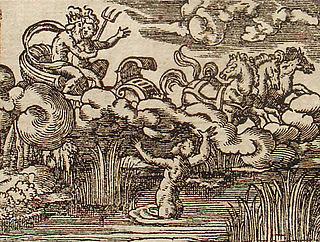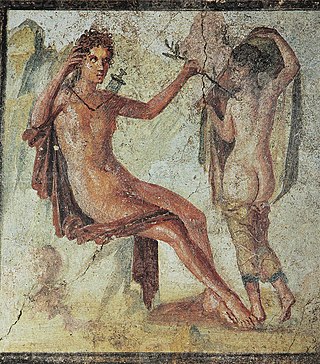| Greek deities series |
|---|
| Nymphs |

Salmacis (Ancient Greek : Σαλμακίς) was an atypical Naiad nymph of Greek mythology. She rejected the ways of the virginal Greek goddess Artemis in favour of vanity and idleness.
| Greek deities series |
|---|
| Nymphs |

Salmacis (Ancient Greek : Σαλμακίς) was an atypical Naiad nymph of Greek mythology. She rejected the ways of the virginal Greek goddess Artemis in favour of vanity and idleness.
Salmacis' attempted rape of Hermaphroditus is narrated in the fourth book of Ovid's Metamorphoses (see also Dercetis).
There dwelt a Nymph, not up for hunting or archery:
unfit for footraces. She the only Naiad not in Diana’s band.
Often her sisters would say: "Pick up a javelin, or
bristling quiver, and interrupt your leisure for the chase!"
But she would not pick up a javelin or arrows,
nor trade leisure for the chase.
Instead she would bathe her beautiful limbs and tend to her hair,
with her waters as a mirror.
One day, Hermaphroditus went swimming in his pool. Upon seeing him, Salmacis was struck with love for him, approached him and confessed her love to him; but he was not interested, and demanded she leave. She did so, but her passion took her back, unable to stay away from him. [1] As Hermaphroditus emerged from the pool, she threw herself at him, and forcibly kissed him as he tried to escape. Salmacis then cried to the gods and begged them to let them stay together forever; and the gods answered by fusing them together for all time, into a deity that had both male and female parts. She thus becomes one with Hermaphroditus and he curses the fountain to have the same effect on every other person who would bathe there. [2]
In a description found on the remains of a wall in Halicarnassus, Hermaphroditus' mother Aphrodite names Salmacis as the nymph who nursed and took care of an infant Hermaphroditus after his parents put him in her care, a very different version than the one presented by Ovid. [3]
Lucian of Samosata also implies that Hermaphroditus was born like that, rather than becoming later in life against his will, and blames it on the identity of the boy's father Hermes. [4]
Salmacis was the name of a fountain or spring located in modern-day Bodrum, Turkey. According to some classical authors, the water had the reputation of making men effeminate and soft. This legend lies at the heart of Ovid's tale of Salmacis and Hermaphroditus.
A fresco in Room 10 of the Casa della Venere in Conchiglia (House of Venus in the Shell) in Pompeii depicts Eros standing in between Hermaphroditus and Salmacis. The fresco is possibly the earliest (before 79 AD) and the only ancient artwork of the water nymph before her union with Hermaphroditus. [5]
Francis Beaumont, a poet and playwright, wrote a poem Salmacis and Hermaphroditus based on Ovid's work. The poem was published anonymously in London in 1602. [6]
Algernon Charles Swinburne's 1863 poem "Hermaphroditus", based on the Bernini sculpture of the same name in the Louvre, makes mention of Salmacis in the final stanza.
A novel of short stories by Italian writer Mario Soldati called Salmace (Salmacis), a title that spans the entire collection. In the story it tells of the transformation of a man into a woman, in a highly metaphorical context. [7]

A sculpture by François-Joseph Bosio, La nymphe Salmacis from 1826, can be seen on display at the Louvre Museum in Paris. [8]
A sculpture by Sir Thomas Brock of Salmacis (aka The Bather Surprised) [9] was designed in 1868. It was modelled and exhibited at the Royal Academy, London in 1869. A variety of porcelain replicas were made from 1875 and an example was exhibited at the Paris Exhibition of 1878. [10]
The Fontana Greca ("Greek Fountain") is a fountain from the Renaissance period located in Gallipoli, southern Italy. The fountain has bas-reliefs depicting three metamorphoses in Greek mythology. The center bas-relief shows Eros flying beside Aphrodite, while Hermaphroditus and Salmacis are shown below laying together and embracing.

A painting of Salmacis in 1877 by French artist Charles Landelle was one of the most admired works at the Paris Exhibition according to The Art Journal of 1878. The painting depicts a startled Salmacis seated among reeds, clutching her drapery to her chest in alarm. [11]
The British progressive rock band Genesis wrote and performed a song entitled "Fountain of Salmacis" on their 1971 album Nursery Cryme . It tells the story of Salmacis' attempted rape of Hermaphroditus. At the end of the song, the lyrics state that Salmacis and Hermaphroditus were "joined as one" and forever live beneath the lake from which the fountain appears.[ citation needed ]

A nymph is a minor female nature deity in ancient Greek folklore. Distinct from other Greek goddesses, nymphs are generally regarded as personifications of nature; they are typically tied to a specific place, landform, or tree, and are usually depicted as maidens. Because of their association with springs, they were often seen as having healing properties; other divine powers of the nymphs included divination and shapeshifting. Nymphs, like other goddesses, were immortal except for the Hamadryads, whose lives were bound to a specific tree.

In Greek mythology, Scylla is a legendary, man-eating monster who lives on one side of a narrow channel of water, opposite her counterpart, the sea-swallowing monster Charybdis. The two sides of the strait are within an arrow's range of each other—so close that sailors attempting to avoid the whirlpools of Charybdis would pass dangerously close to Scylla and vice versa.

Arachne is the protagonist of a tale in Greek mythology known primarily from the version told by the Roman poet Ovid (43 BCE–17 CE), which is the earliest extant source for the story. In Book Six of his epic poem Metamorphoses, Ovid recounts how the talented mortal Arachne challenged the goddess Athena to a weaving contest. When Athena could find no flaws in the tapestry Arachne had woven for the contest, the goddess became enraged and beat the girl with her shuttle. After Arachne hanged herself out of shame, she was transformed into a spider. The myth both provided an etiology of spiders' web-spinning abilities and was a cautionary tale about hubris.

Daphne, a figure in Greek mythology, is a naiad, a variety of female nymph associated with fountains, wells, springs, streams, brooks and other bodies of freshwater.
In Greek mythology, Oebalus, also spelled Oibalus or Oibalius, was a king of Sparta.

In Greek mythology, Hermaphroditus was a child of Aphrodite and Hermes. According to Ovid, he was born a remarkably beautiful boy whom the naiad Salmacis attempted to rape and prayed to be united with forever. A god, in answer to her prayer, merged their two forms into one and transformed him into a hermaphrodite, he being considered the origin of the name. His name is compounded of his parents' names, Hermes and Aphrodite. He was one of the Erotes.

In Greek mythology, the naiads, sometimes also hydriads, are a type of female spirit, or nymph, presiding over fountains, wells, springs, streams, brooks and other bodies of fresh water.
In Greek mythology, the Limnads or Limnatides or Leimenids were a type of naiad.
In Greek mythology, the Pegaeae were a type of naiad that lived in springs. They were often considered great aunts of the river gods (Potamoi), thus establishing a mythological relationship between a river itself and its springs.

In Greek mythology, Byblis or Bublis was a daughter of Miletus. Her mother was either Tragasia, daughter of Celaenus; Cyanee, daughter of the river-god Meander; or Eidothea, daughter of King Eurytus of Caria. She fell in love with Caunus, her twin brother.

Cyane was a naiad in Greek mythology who tried to prevent Hades from abducting Persephone, her playmate.

In Greek mythology, Endymion was variously a handsome Aeolian shepherd, hunter, or king who was said to rule and live at Olympia in Elis. He was also venerated and said to reside on Mount Latmus in Caria, on the west coast of Asia Minor.

Galatea is the post-antiquity name popularly applied to the statue carved of ivory alabaster by Pygmalion of Cyprus, which then came to life in Greek mythology.

Apollo and Daphne is an Ancient Greek transformation or metamorphosis myth. No written or artistic versions survive from ancient Greek mythology, so it is likely Hellenistic in origin. It was retold by Roman authors in the form of an amorous vignette.

Salmacis or Salmakis was the name of a fountain or spring located in modern-day Bodrum, Turkey. According to some classical authors, the water had the reputation of making men effeminate, soft, and 'woman like'. Ovid famously recounts the myth in his story about Hermaphroditus and the nymph of the spring Salmacis.

In Ancient Greek religion and mythology, the Erotes are a collective of winged gods associated with love and sexual intercourse. They are part of Aphrodite's retinue. Erotes is the plural of Eros, who as a singular deity has a more complex mythology.
Greco-Roman mythology features male homosexuality in many of the constituent myths. In addition, there are instances of cross-dressing, androgyny, and other themes which are grouped under the acronym LGBTQ+.
Menippe in Greek mythology may refer to the following women:
In Greek mythology, Thisbe was a Boeotian nymph, from whom the town of Thisbe derived its name. She may be the naiad of the spring, well or fountain of that town.

In Greek mythology, Clymene or Klymene was the name of an Oceanid nymph loved by the sun god Helios and the mother by him of Phaethon and the Heliades. In most versions, Clymene is the one to reveal to Phaethon his divine parentage and encourage him to seek out his father, and even drive his solar chariot.